GMC SIERRA 2006 Owner's Manual
Manufacturer: GMC, Model Year: 2006, Model line: SIERRA, Model: GMC SIERRA 2006Pages: 600, PDF Size: 3.49 MB
Page 391 of 600
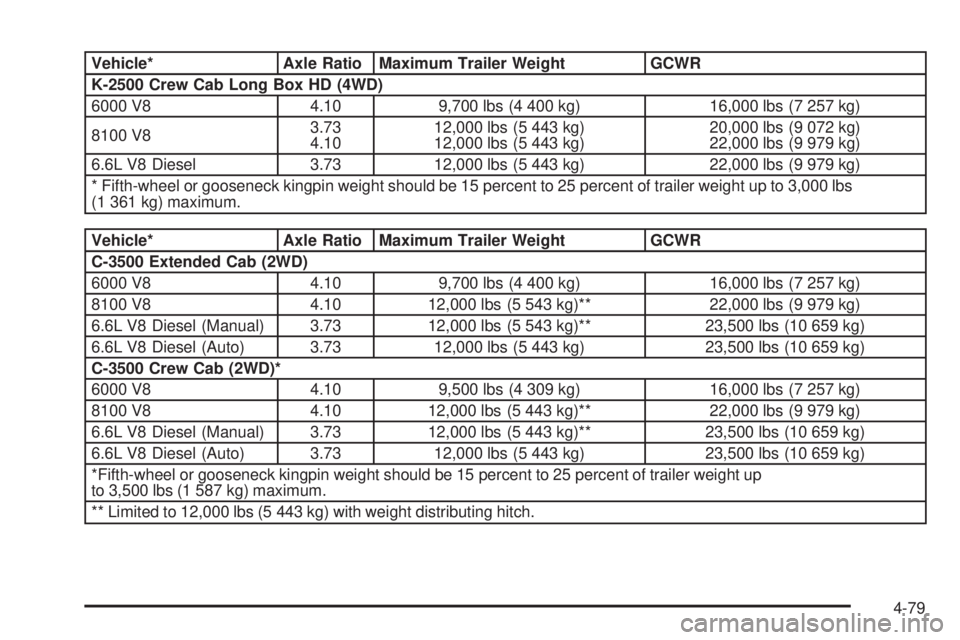
Vehicle* Axle Ratio Maximum Trailer Weight GCWR
K-2500 Crew Cab Long Box HD (4WD)
6000 V8 4.10 9,700 lbs (4 400 kg) 16,000 lbs (7 257 kg)
8100 V83.73
4.1012,000 lbs (5 443 kg)
12,000 lbs (5 443 kg)20,000 lbs (9 072 kg)
22,000 lbs (9 979 kg)
6.6L V8 Diesel 3.73 12,000 lbs (5 443 kg) 22,000 lbs (9 979 kg)
* Fifth-wheel or gooseneck kingpin weight should be 15 percent to 25 percent of trailer weight up to 3,000 lbs
(1 361 kg) maximum.
Vehicle* Axle Ratio Maximum Trailer Weight GCWR
C-3500 Extended Cab (2WD)
6000 V8 4.10 9,700 lbs (4 400 kg) 16,000 lbs (7 257 kg)
8100 V8 4.10 12,000 lbs (5 543 kg)** 22,000 lbs (9 979 kg)
6.6L V8 Diesel (Manual) 3.73 12,000 lbs (5 543 kg)** 23,500 lbs (10 659 kg)
6.6L V8 Diesel (Auto) 3.73 12,000 lbs (5 443 kg) 23,500 lbs (10 659 kg)
C-3500 Crew Cab (2WD)*
6000 V8 4.10 9,500 lbs (4 309 kg) 16,000 lbs (7 257 kg)
8100 V8 4.10 12,000 lbs (5 443 kg)** 22,000 lbs (9 979 kg)
6.6L V8 Diesel (Manual) 3.73 12,000 lbs (5 443 kg)** 23,500 lbs (10 659 kg)
6.6L V8 Diesel (Auto) 3.73 12,000 lbs (5 443 kg) 23,500 lbs (10 659 kg)
*Fifth-wheel or gooseneck kingpin weight should be 15 percent to 25 percent of trailer weight up
to 3,500 lbs (1 587 kg) maximum.
** Limited to 12,000 lbs (5 443 kg) with weight distributing hitch.
4-79
Page 392 of 600
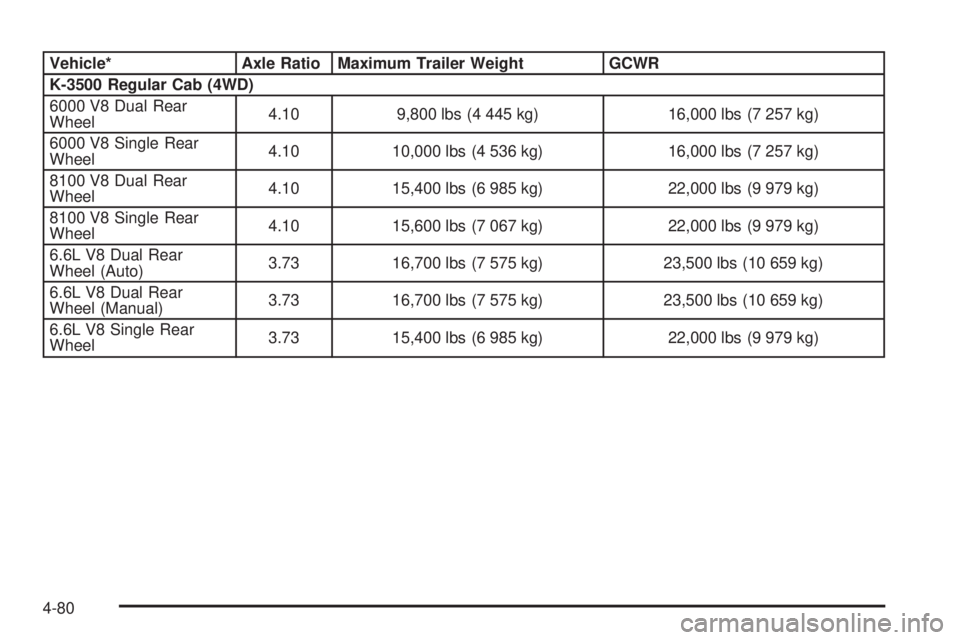
Vehicle* Axle Ratio Maximum Trailer Weight GCWR
K-3500 Regular Cab (4WD)
6000 V8 Dual Rear
Wheel4.10 9,800 lbs (4 445 kg) 16,000 lbs (7 257 kg)
6000 V8 Single Rear
Wheel4.10 10,000 lbs (4 536 kg) 16,000 lbs (7 257 kg)
8100 V8 Dual Rear
Wheel4.10 15,400 lbs (6 985 kg) 22,000 lbs (9 979 kg)
8100 V8 Single Rear
Wheel4.10 15,600 lbs (7 067 kg) 22,000 lbs (9 979 kg)
6.6L V8 Dual Rear
Wheel (Auto)3.73 16,700 lbs (7 575 kg) 23,500 lbs (10 659 kg)
6.6L V8 Dual Rear
Wheel (Manual)3.73 16,700 lbs (7 575 kg) 23,500 lbs (10 659 kg)
6.6L V8 Single Rear
Wheel3.73 15,400 lbs (6 985 kg) 22,000 lbs (9 979 kg)
4-80
Page 393 of 600
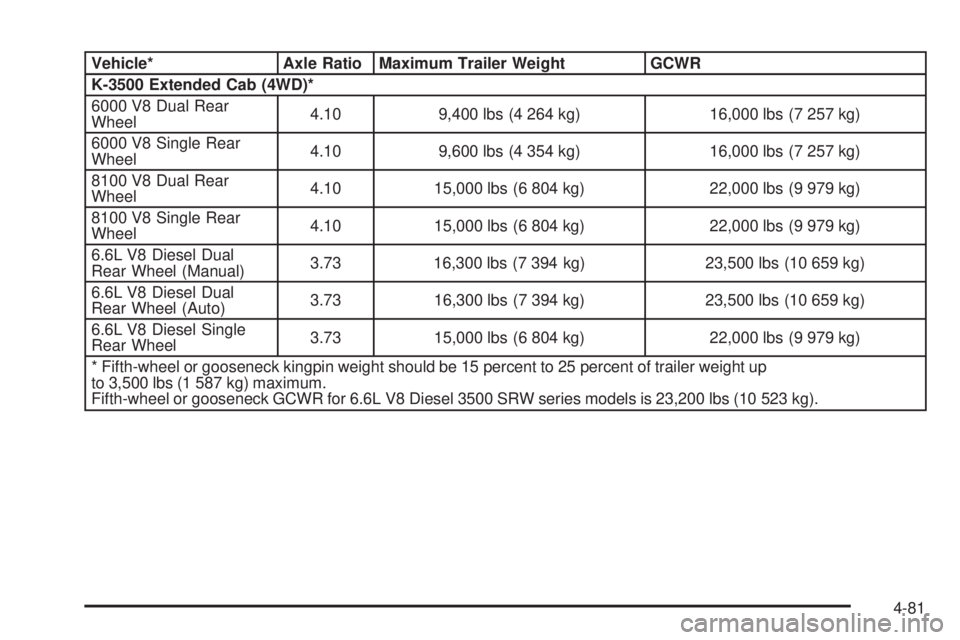
Vehicle* Axle Ratio Maximum Trailer Weight GCWR
K-3500 Extended Cab (4WD)*
6000 V8 Dual Rear
Wheel4.10 9,400 lbs (4 264 kg) 16,000 lbs (7 257 kg)
6000 V8 Single Rear
Wheel4.10 9,600 lbs (4 354 kg) 16,000 lbs (7 257 kg)
8100 V8 Dual Rear
Wheel4.10 15,000 lbs (6 804 kg) 22,000 lbs (9 979 kg)
8100 V8 Single Rear
Wheel4.10 15,000 lbs (6 804 kg) 22,000 lbs (9 979 kg)
6.6L V8 Diesel Dual
Rear Wheel (Manual)3.73 16,300 lbs (7 394 kg) 23,500 lbs (10 659 kg)
6.6L V8 Diesel Dual
Rear Wheel (Auto)3.73 16,300 lbs (7 394 kg) 23,500 lbs (10 659 kg)
6.6L V8 Diesel Single
Rear Wheel3.73 15,000 lbs (6 804 kg) 22,000 lbs (9 979 kg)
* Fifth-wheel or gooseneck kingpin weight should be 15 percent to 25 percent of trailer weight up
to 3,500 lbs (1 587 kg) maximum.
Fifth-wheel or gooseneck GCWR for 6.6L V8 Diesel 3500 SRW series models is 23,200 lbs (10 523 kg).
4-81
Page 394 of 600
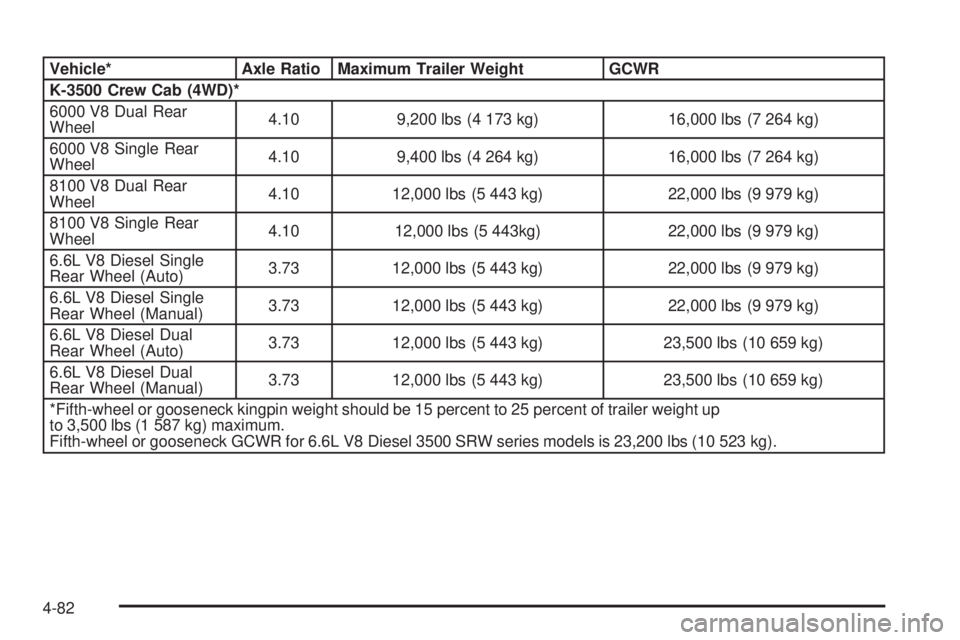
Vehicle* Axle Ratio Maximum Trailer Weight GCWR
K-3500 Crew Cab (4WD)*
6000 V8 Dual Rear
Wheel4.10 9,200 lbs (4 173 kg) 16,000 lbs (7 264 kg)
6000 V8 Single Rear
Wheel4.10 9,400 lbs (4 264 kg) 16,000 lbs (7 264 kg)
8100 V8 Dual Rear
Wheel4.10 12,000 lbs (5 443 kg) 22,000 lbs (9 979 kg)
8100 V8 Single Rear
Wheel4.10 12,000 lbs (5 443kg) 22,000 lbs (9 979 kg)
6.6L V8 Diesel Single
Rear Wheel (Auto)3.73 12,000 lbs (5 443 kg) 22,000 lbs (9 979 kg)
6.6L V8 Diesel Single
Rear Wheel (Manual)3.73 12,000 lbs (5 443 kg) 22,000 lbs (9 979 kg)
6.6L V8 Diesel Dual
Rear Wheel (Auto)3.73 12,000 lbs (5 443 kg) 23,500 lbs (10 659 kg)
6.6L V8 Diesel Dual
Rear Wheel (Manual)3.73 12,000 lbs (5 443 kg) 23,500 lbs (10 659 kg)
*Fifth-wheel or gooseneck kingpin weight should be 15 percent to 25 percent of trailer weight up
to 3,500 lbs (1 587 kg) maximum.
Fifth-wheel or gooseneck GCWR for 6.6L V8 Diesel 3500 SRW series models is 23,200 lbs (10 523 kg).
4-82
Page 395 of 600
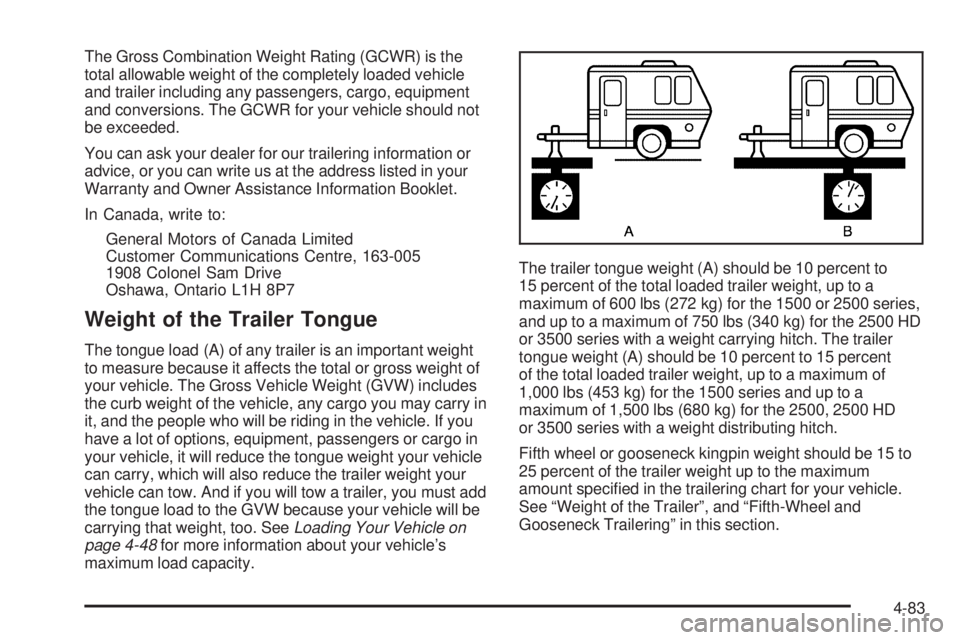
The Gross Combination Weight Rating (GCWR) is the
total allowable weight of the completely loaded vehicle
and trailer including any passengers, cargo, equipment
and conversions. The GCWR for your vehicle should not
be exceeded.
You can ask your dealer for our trailering information or
advice, or you can write us at the address listed in your
Warranty and Owner Assistance Information Booklet.
In Canada, write to:
General Motors of Canada Limited
Customer Communications Centre, 163-005
1908 Colonel Sam Drive
Oshawa, Ontario L1H 8P7
Weight of the Trailer Tongue
The tongue load (A) of any trailer is an important weight
to measure because it affects the total or gross weight of
your vehicle. The Gross Vehicle Weight (GVW) includes
the curb weight of the vehicle, any cargo you may carry in
it, and the people who will be riding in the vehicle. If you
have a lot of options, equipment, passengers or cargo in
your vehicle, it will reduce the tongue weight your vehicle
can carry, which will also reduce the trailer weight your
vehicle can tow. And if you will tow a trailer, you must add
the tongue load to the GVW because your vehicle will be
carrying that weight, too. SeeLoading Your Vehicle on
page 4-48for more information about your vehicle’s
maximum load capacity.The trailer tongue weight (A) should be 10 percent to
15 percent of the total loaded trailer weight, up to a
maximum of 600 lbs (272 kg) for the 1500 or 2500 series,
and up to a maximum of 750 lbs (340 kg) for the 2500 HD
or 3500 series with a weight carrying hitch. The trailer
tongue weight (A) should be 10 percent to 15 percent
of the total loaded trailer weight, up to a maximum of
1,000 lbs (453 kg) for the 1500 series and up to a
maximum of 1,500 lbs (680 kg) for the 2500, 2500 HD
or 3500 series with a weight distributing hitch.
Fifth wheel or gooseneck kingpin weight should be 15 to
25 percent of the trailer weight up to the maximum
amount speci�ed in the trailering chart for your vehicle.
See “Weight of the Trailer”, and “Fifth-Wheel and
Gooseneck Trailering” in this section.
4-83
Page 396 of 600
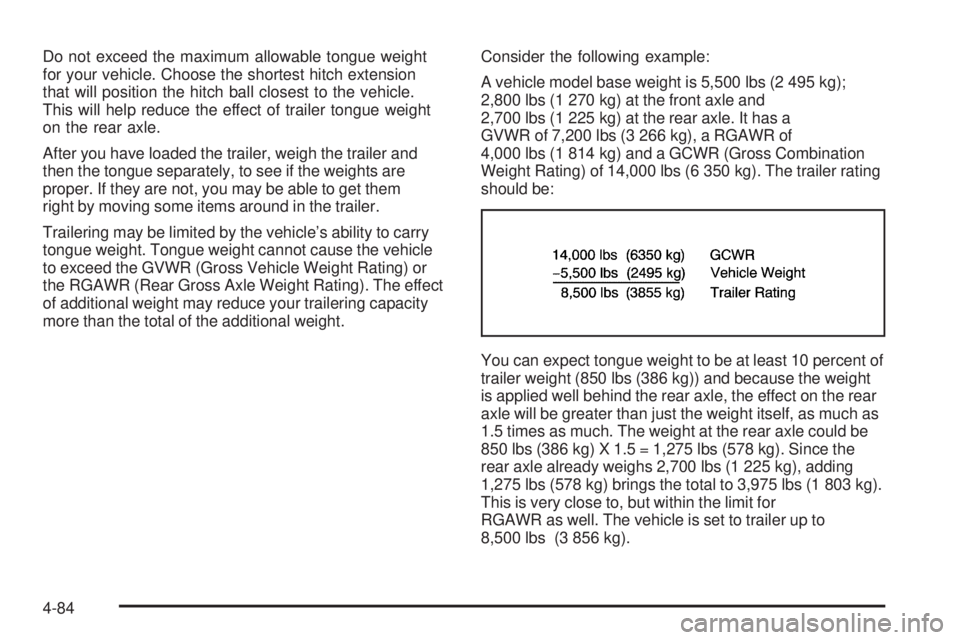
Do not exceed the maximum allowable tongue weight
for your vehicle. Choose the shortest hitch extension
that will position the hitch ball closest to the vehicle.
This will help reduce the effect of trailer tongue weight
on the rear axle.
After you have loaded the trailer, weigh the trailer and
then the tongue separately, to see if the weights are
proper. If they are not, you may be able to get them
right by moving some items around in the trailer.
Trailering may be limited by the vehicle’s ability to carry
tongue weight. Tongue weight cannot cause the vehicle
to exceed the GVWR (Gross Vehicle Weight Rating) or
the RGAWR (Rear Gross Axle Weight Rating). The effect
of additional weight may reduce your trailering capacity
more than the total of the additional weight.Consider the following example:
A vehicle model base weight is 5,500 lbs (2 495 kg);
2,800 lbs (1 270 kg) at the front axle and
2,700 lbs (1 225 kg) at the rear axle. It has a
GVWR of 7,200 lbs (3 266 kg), a RGAWR of
4,000 lbs (1 814 kg) and a GCWR (Gross Combination
Weight Rating) of 14,000 lbs (6 350 kg). The trailer rating
should be:
You can expect tongue weight to be at least 10 percent of
trailer weight (850 lbs (386 kg)) and because the weight
is applied well behind the rear axle, the effect on the rear
axle will be greater than just the weight itself, as much as
1.5 times as much. The weight at the rear axle could be
850 lbs (386 kg) X 1.5 = 1,275 lbs (578 kg). Since the
rear axle already weighs 2,700 lbs (1 225 kg), adding
1,275 lbs (578 kg) brings the total to 3,975 lbs (1 803 kg).
This is very close to, but within the limit for
RGAWR as well. The vehicle is set to trailer up to
8,500 lbs (3 856 kg).
4-84
Page 397 of 600
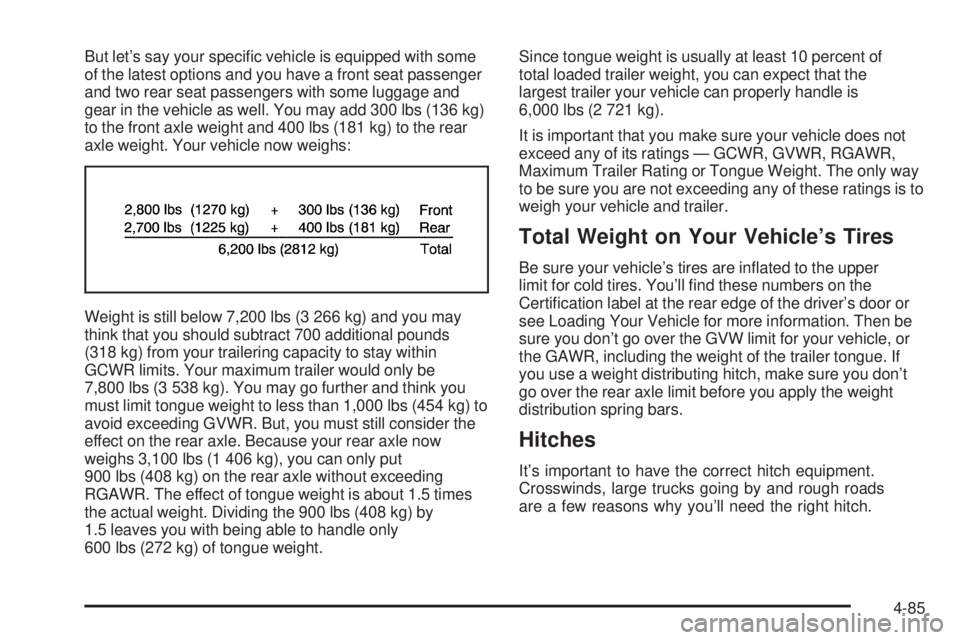
But let’s say your speci�c vehicle is equipped with some
of the latest options and you have a front seat passenger
and two rear seat passengers with some luggage and
gear in the vehicle as well. You may add 300 lbs (136 kg)
to the front axle weight and 400 lbs (181 kg) to the rear
axle weight. Your vehicle now weighs:
Weight is still below 7,200 lbs (3 266 kg) and you may
think that you should subtract 700 additional pounds
(318 kg) from your trailering capacity to stay within
GCWR limits. Your maximum trailer would only be
7,800 lbs (3 538 kg). You may go further and think you
must limit tongue weight to less than 1,000 lbs (454 kg) to
avoid exceeding GVWR. But, you must still consider the
effect on the rear axle. Because your rear axle now
weighs 3,100 lbs (1 406 kg), you can only put
900 lbs (408 kg) on the rear axle without exceeding
RGAWR. The effect of tongue weight is about 1.5 times
the actual weight. Dividing the 900 lbs (408 kg) by
1.5 leaves you with being able to handle only
600 lbs (272 kg) of tongue weight.Since tongue weight is usually at least 10 percent of
total loaded trailer weight, you can expect that the
largest trailer your vehicle can properly handle is
6,000 lbs (2 721 kg).
It is important that you make sure your vehicle does not
exceed any of its ratings — GCWR, GVWR, RGAWR,
Maximum Trailer Rating or Tongue Weight. The only way
to be sure you are not exceeding any of these ratings is to
weigh your vehicle and trailer.
Total Weight on Your Vehicle’s Tires
Be sure your vehicle’s tires are in�ated to the upper
limit for cold tires. You’ll �nd these numbers on the
Certi�cation label at the rear edge of the driver’s door or
see Loading Your Vehicle for more information. Then be
sure you don’t go over the GVW limit for your vehicle, or
the GAWR, including the weight of the trailer tongue. If
you use a weight distributing hitch, make sure you don’t
go over the rear axle limit before you apply the weight
distribution spring bars.
Hitches
It’s important to have the correct hitch equipment.
Crosswinds, large trucks going by and rough roads
are a few reasons why you’ll need the right hitch.
4-85
Page 398 of 600
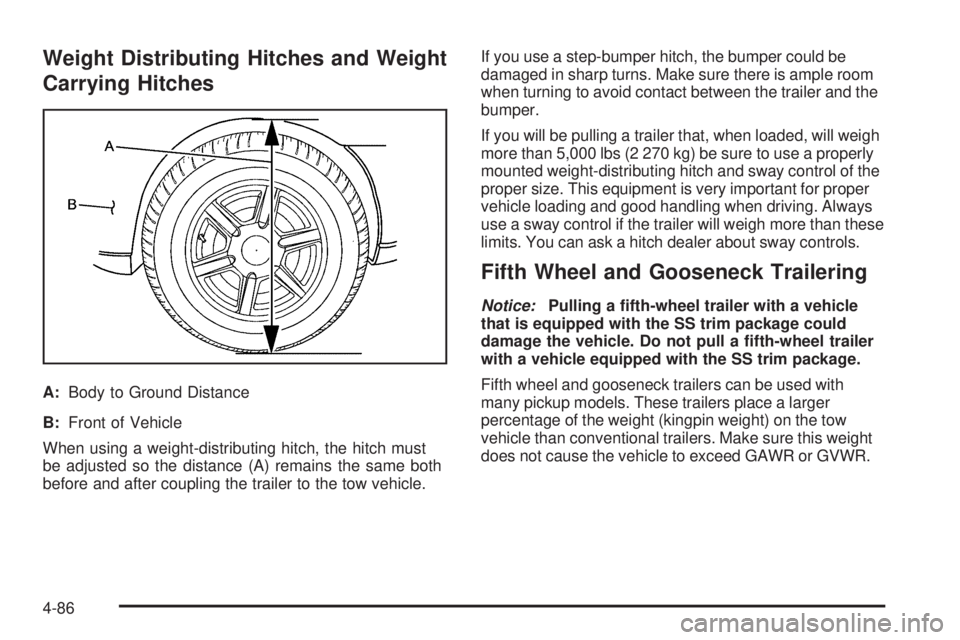
Weight Distributing Hitches and Weight
Carrying Hitches
A:Body to Ground Distance
B:Front of Vehicle
When using a weight-distributing hitch, the hitch must
be adjusted so the distance (A) remains the same both
before and after coupling the trailer to the tow vehicle.If you use a step-bumper hitch, the bumper could be
damaged in sharp turns. Make sure there is ample room
when turning to avoid contact between the trailer and the
bumper.
If you will be pulling a trailer that, when loaded, will weigh
more than 5,000 lbs (2 270 kg) be sure to use a properly
mounted weight-distributing hitch and sway control of the
proper size. This equipment is very important for proper
vehicle loading and good handling when driving. Always
use a sway control if the trailer will weigh more than these
limits. You can ask a hitch dealer about sway controls.
Fifth Wheel and Gooseneck Trailering
Notice:Pulling a �fth-wheel trailer with a vehicle
that is equipped with the SS trim package could
damage the vehicle. Do not pull a �fth-wheel trailer
with a vehicle equipped with the SS trim package.
Fifth wheel and gooseneck trailers can be used with
many pickup models. These trailers place a larger
percentage of the weight (kingpin weight) on the tow
vehicle than conventional trailers. Make sure this weight
does not cause the vehicle to exceed GAWR or GVWR.
4-86
Page 399 of 600
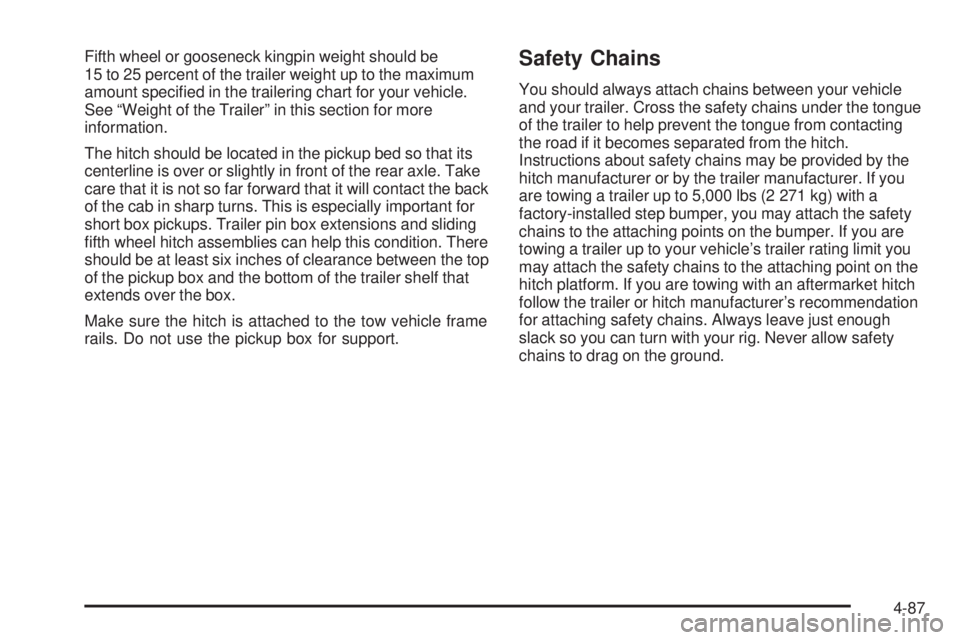
Fifth wheel or gooseneck kingpin weight should be
15 to 25 percent of the trailer weight up to the maximum
amount speci�ed in the trailering chart for your vehicle.
See “Weight of the Trailer” in this section for more
information.
The hitch should be located in the pickup bed so that its
centerline is over or slightly in front of the rear axle. Take
care that it is not so far forward that it will contact the back
of the cab in sharp turns. This is especially important for
short box pickups. Trailer pin box extensions and sliding
�fth wheel hitch assemblies can help this condition. There
should be at least six inches of clearance between the top
of the pickup box and the bottom of the trailer shelf that
extends over the box.
Make sure the hitch is attached to the tow vehicle frame
rails. Do not use the pickup box for support.Safety Chains
You should always attach chains between your vehicle
and your trailer. Cross the safety chains under the tongue
of the trailer to help prevent the tongue from contacting
the road if it becomes separated from the hitch.
Instructions about safety chains may be provided by the
hitch manufacturer or by the trailer manufacturer. If you
are towing a trailer up to 5,000 lbs (2 271 kg) with a
factory-installed step bumper, you may attach the safety
chains to the attaching points on the bumper. If you are
towing a trailer up to your vehicle’s trailer rating limit you
may attach the safety chains to the attaching point on the
hitch platform. If you are towing with an aftermarket hitch
follow the trailer or hitch manufacturer’s recommendation
for attaching safety chains. Always leave just enough
slack so you can turn with your rig. Never allow safety
chains to drag on the ground.
4-87
Page 400 of 600
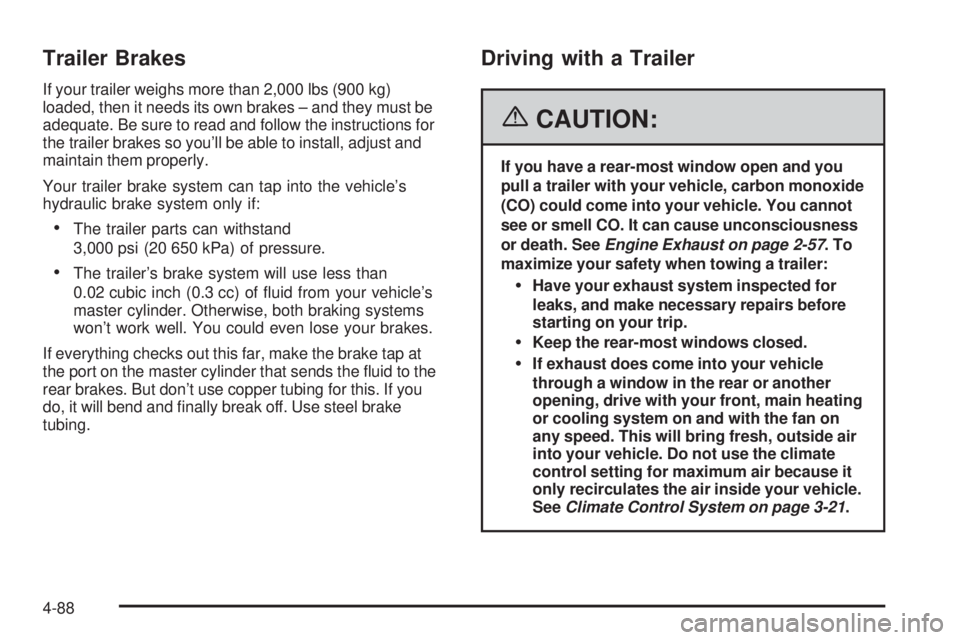
Trailer Brakes
If your trailer weighs more than 2,000 lbs (900 kg)
loaded, then it needs its own brakes – and they must be
adequate. Be sure to read and follow the instructions for
the trailer brakes so you’ll be able to install, adjust and
maintain them properly.
Your trailer brake system can tap into the vehicle’s
hydraulic brake system only if:
The trailer parts can withstand
3,000 psi (20 650 kPa) of pressure.
The trailer’s brake system will use less than
0.02 cubic inch (0.3 cc) of �uid from your vehicle’s
master cylinder. Otherwise, both braking systems
won’t work well. You could even lose your brakes.
If everything checks out this far, make the brake tap at
the port on the master cylinder that sends the �uid to the
rear brakes. But don’t use copper tubing for this. If you
do, it will bend and �nally break off. Use steel brake
tubing.
Driving with a Trailer
{CAUTION:
If you have a rear-most window open and you
pull a trailer with your vehicle, carbon monoxide
(CO) could come into your vehicle. You cannot
see or smell CO. It can cause unconsciousness
or death. SeeEngine Exhaust on page 2-57.To
maximize your safety when towing a trailer:
Have your exhaust system inspected for
leaks, and make necessary repairs before
starting on your trip.
Keep the rear-most windows closed.
If exhaust does come into your vehicle
through a window in the rear or another
opening, drive with your front, main heating
or cooling system on and with the fan on
any speed. This will bring fresh, outside air
into your vehicle. Do not use the climate
control setting for maximum air because it
only recirculates the air inside your vehicle.
SeeClimate Control System on page 3-21.
4-88